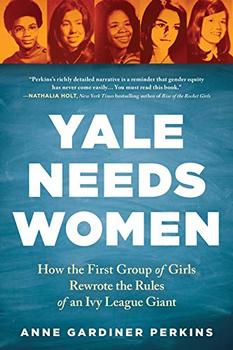Summary | Excerpt | Reading Guide | Discuss | Reviews | Beyond the Book | Read-Alikes | Genres & Themes | Author Bio

How the First Group of Girls Rewrote the Rules of an Ivy League Giant
by Anne Gardiner PerkinsThis article relates to Yale Needs Women
 In Yale Needs Women, author Anne Gardiner Perkins explores the circumstances surrounding Yale University's decision to go coed in 1969, and the experiences of its first female students. Yale's change in policy was hardly revolutionary, as some colleges and universities in the U.S. had been coed since the 19th century.
In Yale Needs Women, author Anne Gardiner Perkins explores the circumstances surrounding Yale University's decision to go coed in 1969, and the experiences of its first female students. Yale's change in policy was hardly revolutionary, as some colleges and universities in the U.S. had been coed since the 19th century.
Oberlin College in Ohio was the first higher learning institution to admit women in the United States. The college opened in 1833, permitted Blacks to apply in 1835, and became coed in 1837 with the admission of four female students. Three of the four graduated with a Bachelor of Arts in 1841. The fourth, Mary Kellogg, had to drop out because she could no longer afford the tuition, but later returned to finish after she was married (to future Oberlin College president James Harris Fairchild). In 1862, Mary Jane Patterson graduated from Oberlin, becoming the first Black woman in the United States to earn a Bachelor's degree. In 1860, James Harris Fairchild gave a speech called "Joint Education of the Sexes" in which he declared with regard to men and women, "neither can be elevated without the other...their responsibilities in the work of life, though different, are equal." He went on to note that in this particular year there were approximately 500 women at Oberlin, making up about 40% of the student body. Famed feminist and abolitionist Lucy Stone graduated from Oberlin in 1847, and was employed by the American Anti-Slavery Society just a year later.
Franklin College in Indiana began admitting women in 1842, followed by Michigan's Hillsdale College in 1844. Like Oberlin, Hillsdale accepted Black students as well. The school's first female graduate was Elizabeth Camp, who earned a Bachelor's of Science in 1851. Hillsdale notes in its official history, however, that college clubs and societies were not coed, and that socializing between the sexes was strictly monitored: "If a couple so much as wanted to take a walk together, special permission was required from the college president or dean of women."
Baylor University in Texas was open to admitting female students from its founding in 1845, though this policy fluctuated over the years. The school awarded its first "Maid of Arts" to a woman, Mary Gentry Kavanaugh, in 1855. Otterbein University in Westerville, Ohio was founded in 1847 by the Church of the United Brethren in Christ with an open-door policy for women (and people of color), who were permitted to take the same courses as male students. Otterbein's first graduating class included two female students.
Cornell University was the only ivy league school to admit women from its founding (in 1865), and the others did not go coed until the 1960s-1980s. Columbia University was the last holdout, finally opening its doors to women in 1983.
by Lisa Butts
Women of Oberlin College, 1850s, courtesy of Oberlin College Archives
Filed under People, Eras & Events
![]() This "beyond the book article" relates to Yale Needs Women. It originally ran in September 2019 and has been updated for the
July 2021 paperback edition.
Go to magazine.
This "beyond the book article" relates to Yale Needs Women. It originally ran in September 2019 and has been updated for the
July 2021 paperback edition.
Go to magazine.
If there is anything more dangerous to the life of the mind than having no independent commitment to ideas...
Click Here to find out who said this, as well as discovering other famous literary quotes!
Your guide toexceptional books
BookBrowse seeks out and recommends the best in contemporary fiction and nonfiction—books that not only engage and entertain but also deepen our understanding of ourselves and the world around us.